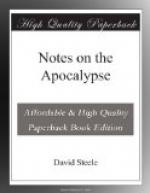nations and kingdoms that would not
serve her,
have perished; yea, those nations have been utterly
wasted.” (Is. xlix. 23; lx. 12.)—The
souls which the apostle saw under the altar, whose
cry for vengeance he heard, and who were directed to
rest for a little season, till the roll of their martyred
brethren should be completed, are here presented in
quite a new position, “sitting on thrones,”
(ch. vi. 9.) Although they are not the same identical
persons
physically, they are the same
morally;
for the life of the two witnesses is commensurate
with the reign of Antichrist,—twelve hundred
and sixty years. These “lived and reigned
with Christ a thousand years; that is, in their successive
generations: for otherwise they would over-live
the age of Methuselah!—Souls are here evidently
persons, and not souls as distinct from bodies, as
some needlessly argue against Millenarians: for
“foreheads” and “hands” are
attributed to them: but foreheads cannot be literally
ascribed to those who had been “beheaded.”
Their living is to be understood of their succeeding
to the same scriptural position occupied by their
predecessors, as well as succeeding them in the order
of natural generation. The Holy Spirit says,
“Levi, who receiveth tithes, paid tithes in
Abraham.” (Heb. vii. 9, 10.) Elijah reappeared
in the person of John the Baptist. (Matt. xi. 14.)
Jezebel and Balaam were recognised in their wicked
successors, (ch. ii. 14, 20.) But this is the very
structure of the Apocalypse, being composed of hieroglyphics,
that the free agency of the wicked might be left untrammelled,
and the diligence of God’s people might be tested
in “searching the Scriptures.”
5. But the rest of the dead lived not again until
the thousand years were finished. This is the
first resurrection.
V. 5.—“The rest of the dead”
supposes two classes of the dead. These are the
witnesses, who died a violent and cruel death, and
the wicked, who died a natural death,—there
“were no bands in their death.” As
there are two kinds of death, so are there two
kinds of resurrection,—a first and
second of each. Those who had been “beheaded
for the witness of Jesus,” etc., lived in
their successors,—sat on thrones, reigned
with Christ a thousand years. Of course those
who were slain by Christ and his army at the battle
of Armageddon, and whose flesh was given to the fowls
of heaven, “lived not again” in their
successors, “until the thousand years were finished.”
Consequently, “this is the first resurrection,”
with which the true disciples of Christ shall be honoured.
They must, however, die as all others, and await the
second resurrection: but “on them
the second death shall have no power.”
6. Blessed and holy is he that hath part in the
first resurrection; on such the second death hath
no power; but they shall be priests of God and of
Christ, and shall reign with him a thousand years.




